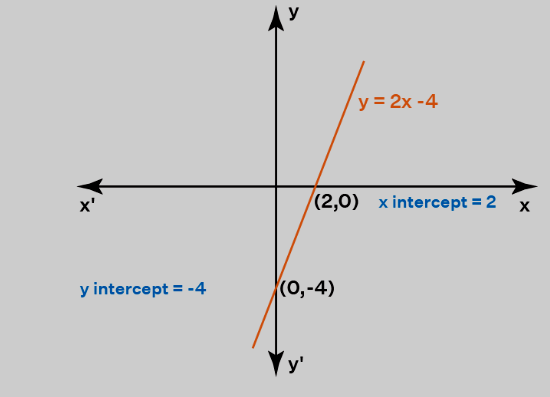
X Intercept Formula: The x-intercept of a curve signifies the x-coordinate value where the graph intersects the x-axis. In simpler terms, it's the point where the y-coordinate equals zero. Understanding the x-intercept is crucial in graph analysis.
X Intercept Formula
Several formulas are associated with intercepts, derived by setting y = 0 in equations and solving for x. Here are some key formulas:
General Form of a Line: ax + by + c = 0
x-intercept = -c/a
Slope-Intercept Form: y = mx + c
x-intercept = -c/m
Point-Slope Form: y - b = m(x - a)
x-intercept = (am - b)/m
Intercept Form: x/a + y/b = 1
x-intercept = (a, 0)
Also Check - Comparing Quantities FormulaFinding X Intercept on a Graph
To find the x-intercept of a line represented by y = mx + b, simply substitute y = 0 into the equation and solve for x. For instance, if you have the equation y = 2x - 4:
Example:
0 = 2x - 4
4 = 2x
2 = x
So, the x-intercept of y = 2x - 4 is 2.
 Also Check -
Introduction to Graph Formula
Also Check -
Introduction to Graph Formula
Finding Equation of a Line Using X Intercept
Let's say you're given a slope (m) and an x-intercept (-5) and need to find the equation of a line. Follow these steps:
Use the x-intercept formula: x = -c/m
Substitute the values: -5 = -c/2
Solve for c: c = 10
Now, plug the values of c and m into the equation y = mx + c:
Equation of the line: y = 2x + 10
Also Check - Logarithm FormulaX Intercept Examples
Example 1:
Given 2y = 3x - 6, calculate the x-intercept and y-intercept.
Solution:
x-intercept: 2x = 3x - 6 => 2x = 6 => x = 3
y-intercept: 2y = -6 => y = -3
So, the line has an x-intercept of 3 and a y-intercept of -3.
Example 2:
A line with slope -2 passes through point P(a, 1). If the sum of both intercepts equals 6, find the value of a.
Solution:
General equation: y - 1 = -2(x - a)
x-intercept = 1/2 + a
y-intercept = 1 + 2a
Sum of intercepts: 1/2 + a + 1 + 2a = 3a + 5/2
Set this equal to 6 and solve for a:
3a + 5/2 = 6
3a = 11/2
a = 3/2
So, the value of a is 3/2.
Example 3:
Calculate the x-intercept of the parabola y = x^2 - 3x + 2.
Solution:
Set y = 0 in the equation:
0 = x^2 - 3x + 2
Solve for x:
x = 2 and x = 1
The parabola intersects the x-axis at x = 2 and x = 1.
Example 4:
Determine the x-intercepts of the equation 3x + 2y = 6.
Solution:
Rearrange the equation: 2y = -3x + 6
Divide by 2: y = (-3/2)x + 3
To find the x-intercept, set y = 0 and solve for x:
0 = (-3/2)x + 3
(-3/2)x = -3
x = (-3)/(-3/2) = 2
So, the x-intercept of 3x + 2y = 6 is 2.
Example 5:
Given the equation of a circle as (x - 4)^2 + y^2 = 16, find the x-intercepts.
Solution:
Set y = 0 in the equation:
(x - 4)^2 + 0 = 16
Simplify and solve for x:
(x - 4)^2 = 16
x - 4 = ±√16
x - 4 = ±4
x = 4 ± 4
So, the x-intercepts are x = 8 and x = 0.
Example 6:
Find the x-intercepts of the quadratic function f(x) = 2x^2 - 5x - 3.
Solution:
To find the x-intercepts of the quadratic equation 2x^2 - 5x - 3 = 0, we can use the quadratic formula:
x = (-(-5) ± √((-5)^2 - 4(2)(-3))) / (2(2))
Simplifying further:
x = (5 ± √(25 + 24)) / 4
x = (5 ± √49) / 4
x = (5 ± 7) / 4
Therefore, the x-intercepts of the function f(x) = 2x^2 - 5x - 3 are x = 3/2 and x = -1.
Example 7:
For the exponential function y = 2^x, find the x-intercept.
Solution:
Set y = 0:
2^x = 0
However, 2^x is always positive for any real value of x, so it does not have an x-intercept in the real number system.
In this case, there is no real x-intercept for the exponential function y = 2^x because exponential functions never equal zero for real values of x.
These additional examples showcase how to find x-intercepts in various types of equations and functions, including linear, quadratic, and exponential forms.
X Intercept Formula FAQs
What is the x-intercept of a linear equation?
How do you find the x-intercept of a line?
What's the formula for finding the x-intercept of a line in general form?
In slope-intercept form, how do you find the x-intercept of a line?
Can you find the x-intercept of a parabola?










